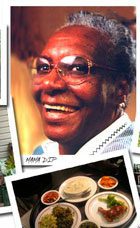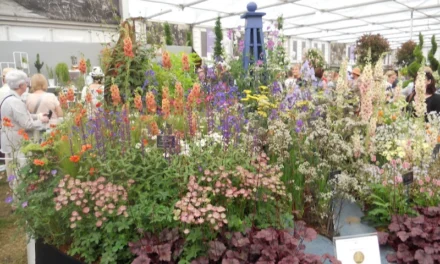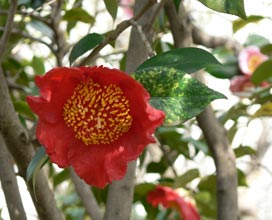Mildred Edna Cotton Council (aka Mama Dip) was born and raised on a sharecropper farm during the Great Depression in Chatham County, North Carolina.
 She started cooking at an early age. Mildred was the youngest of seven, and was dubbed “Dip” by her siblings because she was so tall and had such long arms that she could reach way down in the rain barrel to scoop up a big gourd full of water for them all to all when the level was low. Mama Dip first learned to cook watching family members make meals by using the “dump cooking” method. Dump cooking means no recipes, just measure by eye, feel, taste, and testing.
She started cooking at an early age. Mildred was the youngest of seven, and was dubbed “Dip” by her siblings because she was so tall and had such long arms that she could reach way down in the rain barrel to scoop up a big gourd full of water for them all to all when the level was low. Mama Dip first learned to cook watching family members make meals by using the “dump cooking” method. Dump cooking means no recipes, just measure by eye, feel, taste, and testing.
“I grew up and lived in poverty most of my life never knowing it. My children, too, grew up in poverty never knowing that they were poor. Our house just leaked. No screen doors. An outdoor bathroom. Little money. But lots of love.”
 She started ‘Mama Dips’ restaurant in Chapel Hill in 1976 with $64 and it was an instant hit. Word of its popularity spread far and wide and in the 80s Craig Claiborne, Food Critic for the New York Times, came to town and gave it a rave review; visits from many national and international celebrities followed. In the 90’s Mama Dip made her famous pecan pie for Thanksgiving on Good Morning America, and the restaurant moved to new, larger premises. Now in her 80’s, Mama is still going strong, and you can usually find her in her favorite chair in her restaurant. I loved eating at Mama’s when I lived near there. Her philosophy of using “simply prepared locally grown seasonal produce’” is now all the rage with the biggest chefs in America. But she was just doing what she had always done, being raised so close to the land and doing her own gardening.
She started ‘Mama Dips’ restaurant in Chapel Hill in 1976 with $64 and it was an instant hit. Word of its popularity spread far and wide and in the 80s Craig Claiborne, Food Critic for the New York Times, came to town and gave it a rave review; visits from many national and international celebrities followed. In the 90’s Mama Dip made her famous pecan pie for Thanksgiving on Good Morning America, and the restaurant moved to new, larger premises. Now in her 80’s, Mama is still going strong, and you can usually find her in her favorite chair in her restaurant. I loved eating at Mama’s when I lived near there. Her philosophy of using “simply prepared locally grown seasonal produce’” is now all the rage with the biggest chefs in America. But she was just doing what she had always done, being raised so close to the land and doing her own gardening.
I bought her wonderful cookbook (Mama Dip’s Kitchen — the University of North Carolina Press) and I was really struck by the simple beauty and spirituality with which she wrote about gardening and what it meant to her. I wanted to share it with you, so here it is:
Grace
by Mama Dip
Sometimes I think my life is a lot like a pumpkin seed. Many years ago I took a pumpkin seed – one of God’s ugliest seeds – and planted it in the earth. In a few days it sprouted two green leaves. I chopped, tilled, watered, and fed it. The rain fell on it and I tilled it again, and soon I had a long vine with blooms on it growing everywhere. By Halloween time I had two pumpkins, one small and one large.
I made a snaggle-toothed jack-o’-lantern out of the big one, scooping it out through the cut-off top and placing a broken candle inside. When I called the children in to see it, they could see the light of life shining in its ugly face. I peeled and cooked the other pumpkin and made pies and bread, which I shared with neighbors and some of the sick and shut-ins. But I still had all of these seeds left, so I put them in a pan out on the back steps. As I looked out the window later, I saw a bird, a squirrel, a butterfly, and even a bumble bee come and sit on the seeds. And I said to myself, “Heavenly Father, look what your ugly seeds have done. They have made children, my neighbors, the sick, the birds, bees, squirrels, and butterflies all happy.”
This made me realize something I’ve thought about so many times since. My life through this pumpkin seed, brought so much happiness and joy. Like the pumpkin seed, my life can continue to bring joy and happiness to others.
When I plant my garden in the spring, I do it with the thought that one single bean can create so many new beans, half a pound or more. How many plants will come from one bean if you till it, feed it, and water it?
One spring as I walked across my yard, I noticed a flower growing that I didn’t even plant. One of the birds had probably dropped a seed from which it grew. I felt sorry that the bird had lost some food that may have been meant for its babies. So I dug up the plant and replanted it in my garden, while I gave silent thanks both to God and the bird.
We don’t eat flowers, but I plant them in my garden with the thought of life and beauty which is what they represent. They represent love, happiness, and concern. When you see a bundle of flowers, your eyes light up, even if they are not for you. Flowers are like thoughts and people because there are so many kinds and colors and different names for them.
When I went to cash the first paycheck I ever got for cooking, the grocery store cashier pushed it back over the counter to me and said I would have to sign my name on the back of it. I realized then that my name was my earthly soul, which needed to be tended like the pumpkin seed – tended, tilled, fed, and harvested, to have a good life. And that’s what I’ve tried to do ever since for my family and myself.








